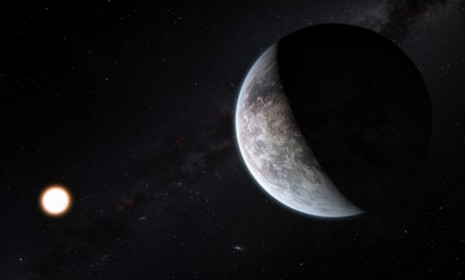Discovered: A 'super-Earth' that may harbor life
Astronomers have identified 50 new planets — and one is potentially hospitable to life as we know it

Astronomers have announced the discovery of 50 new planets orbiting stars like our sun, and one of these — named HD85512b — is generating excitement among scientists as a possible candidate for harboring life. This extraordinary haul of new planets, made by a team of astronomers using data gathered at the European Southern Observatory in Chile, increases the number of known "exoplanets" orbiting distant suns to 573. Here, a brief guide:
How did astronomers discover these planets?
They used an instrument known as the High Accuracy Radial velocity Planet Searcher, or HARPS. The HARPS instrument can tell when a distant star "wobbles" slightly. This consistent pattern of back-and-forth movement suggests that a distant star is being orbited by a planet, and the star's wobbling is the result of that planet's gravitational pull. That's how the astronomers located 16 "super-Earths" among the 50 new planets.
The Week
Escape your echo chamber. Get the facts behind the news, plus analysis from multiple perspectives.

Sign up for The Week's Free Newsletters
From our morning news briefing to a weekly Good News Newsletter, get the best of The Week delivered directly to your inbox.
From our morning news briefing to a weekly Good News Newsletter, get the best of The Week delivered directly to your inbox.
What exactly is a "super-Earth"?
Any planet that's up to 10 times the size of Earth. Dozens are known to exist. These planets may be rocky or gaseous, and there's no guarantee that they are in the "Goldilocks" zone of not too hot and not too cold to contain liquid water or other criteria needed to sustain life. However, many astronomers believe that a planet the size of a super-Earth is the ideal place for finding the right conditions for biological activity.
Could planet HD85512b really harbor life?
Maybe. The conditions seem ideal, since the planet is close enough to its sun to have liquid water on its surface, and its size suggests that it could have a solid, rocky surface. "If we are really, really lucky, this planet could be a habitat" says astronomer Lisa Kaltenegger of the Max Planck Institute in Germany, as quoted by The Washington Post.
A free daily email with the biggest news stories of the day – and the best features from TheWeek.com
How will we know for sure
First, astronomers need a photograph of the planet to look for signs of water, carbon dioxide, and other compounds. No telescope is sensitive enough for that high-resolution image, since the planet is about 36 light-years away. But construction on a powerful new telescope, the European Extremely Large Telescope, will begin next year, and that instrument could answer many questions about distant planets like HD85512b.
Sources: MSNBC.com, Space.com, Washington Post


